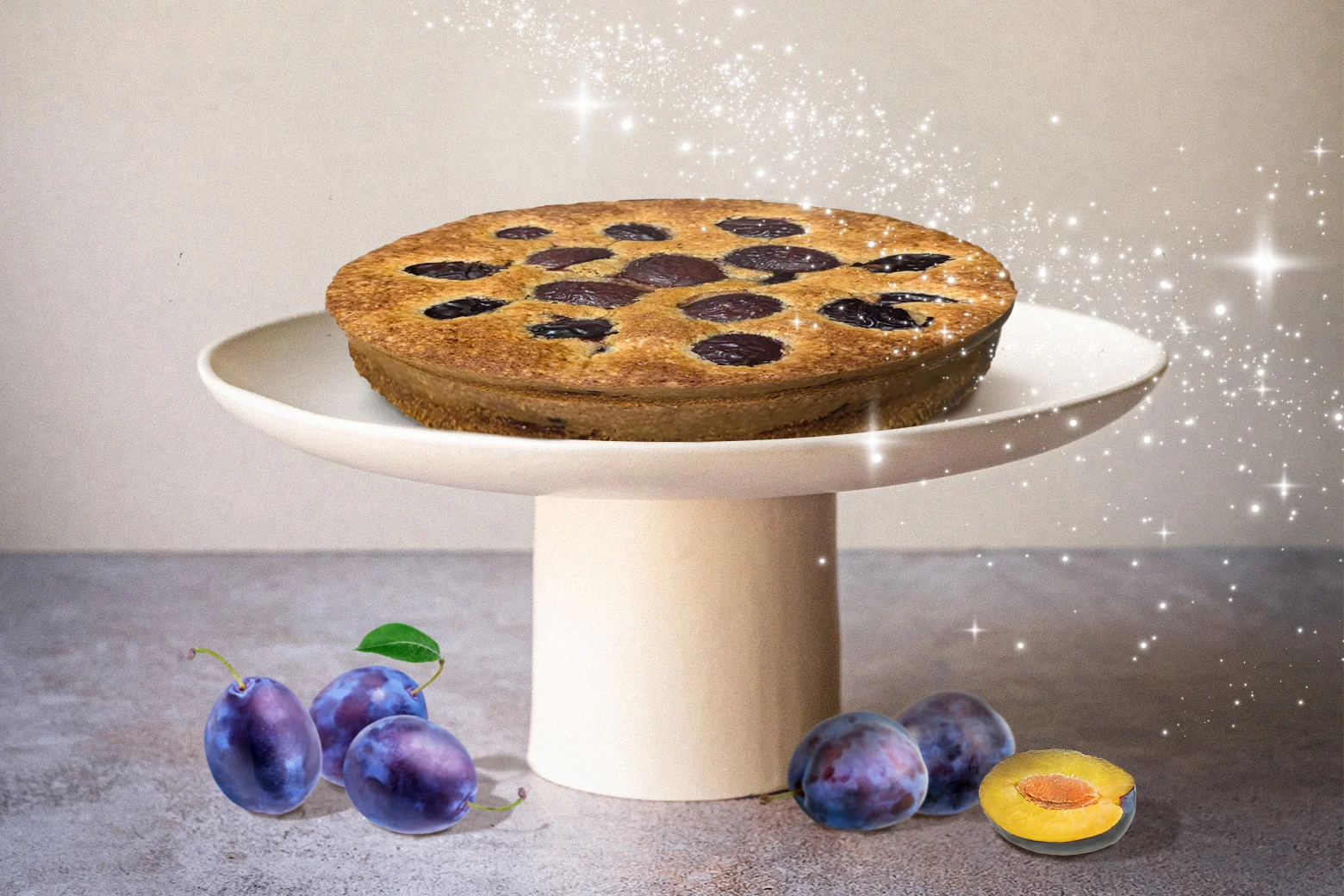
Sign up for the Slatest to get the most insightful analysis, criticism, and advice out there, delivered to your inbox daily.
They are not many of us who could say, at the end of our lives, that we once caused a rebellion against the New York Times, but Marian Burros could—and proudly so. The respected reporter, editor, and cookbook author died on Saturday at 92, leaving behind a rich body of food writing, food-safety and health journalism (including the revelation that the secret ingredient of a hip 1970s low-cal bread alternative was wood pulp), and recipes. But the real standout of her work—at least according to the baking public—was her “Plum Torte,” a simple, fruit-studded cake that has been one of the Times’ most popular recipes since it was first published in the early 1980s. The rebellion? That happened in the form of a deluge of distraught letters to the paper when, after a few years of annual reprints, the editors dared announce that they would no longer be running it in its usual September slot.
After the news of Burros’ passing broke, the comments section on the New York Times Cooking entry for the torte likewise filled with sweet notes from dedicated fans as well as bakers revisiting it after many years or discovering it for the first time. “Marion Burros, thank you for this end-of-summer gift,” one commenter wrote. “With half the torte in the fridge, it seems to me a special moment to wish you farewell.”
Another thing you’ll notice, if you scroll through the comments, is many people offering important clarifications and caveats to the original instructions. This makes sense, because the truth is, having baked my share and tasted many, the Plum Torte could actually use a little help. It can tend toward dry, bland, and even singed; the flavor of the tart, earthy plums can be overwhelmed by too much sugar; and certain aspects of the brisk directions can quickly become pitfalls. Not because it is a bad recipe (it is not!), but precisely because it is so beloved.
Indeed, the torte’s story is a curious one—a cherished recipe that nonetheless leaves much room for error, that could easily be polished up without any harm to its lovely soul, and yet is so revered as to seem untouchable. So, in the spirit of showing respect to an artist’s work by engaging with it critically—and to help out those, like me, currently preheating the oven in Burros’ memory—I decided to try to better understand this iconic dessert, and to dust it off for a new generation of bakers and enjoyers alike.
For the uninitiated, the Plum Torte is a no-nonsense single-layer cake studded with purple plums, traditionally the oblong Italian prune plum or a similar, slightly larger variety called “Empress.” It became associated with this time of year—during the fitful surrender of summer to actual fall—because that is when these plums pop up in New York Times country. In theory, the torte is my favorite kind of dessert: easy to make (and make ahead); rustic, but attractive to present (warm with a scoop of vanilla ice cream); and, without that garnish, perfectly defensible with your coffee the next morning. But the recipe is deceptively simple—if you follow it to the letter (and there aren’t many there), it’s a tossup as to whether you’ll get a happy result. What we have here, I’ve come to feel, is a cake trapped in amber, and historical fidelity is not doing modern bakers any favors.
The Plum Torte is a recipe that comes dusted with lore—quite a lot, in fact, for such an unassuming cake. As the headnote on the NYT Cooking entry will tell you, the original version first appeared in the paper in 1983. It was part of a helpful little feature called “Buy of the Week”: the thrifty deal that week was prune plums (“available at many markets in the region for 39 to 49 cents a pound”) and, as Burros cheerfully put it, the recipe was one that “shows off the little purple plums … to their best advantage.” Readers enthusiastically agreed, and the Times ran the recipe annually in September until 1989, when home bakers were encouraged to stop sending requests and just clip the thing already.
According to a thorough history reprinted on the recipe’s 40th anniversary in 2023, this last call inspired a surprising outpouring of emotion, ranging from admonishments (“Don’t be grumpy about it”) to meditations (“Perhaps, it has become the adult version of September’s shiny new notebook for school”) to poetry. The torte called for only nine common ingredients, but clearly, bakers had imbued it with far more: melancholy for the end of summer, excitement for the arrival of fall, saudade for the passing of time. In many local Jewish households, as Melissa Clark reports, the torte earned pride of place on the Rosh Hashana table each new year. It’s clear that baking the Plum Torte became a seasonal ritual for many, almost pagan in feel: Take the ripe stone fruit, the last of summer’s bounty, and wrap it in the cinnamon-warmth of a rising batter as the chill of the colder months creeps in under the eaves.
Examined this way, the torte’s veneration starts to track. And it’s no surprise that since it migrated online with the rest of the Times’ culinary archive, the recipe’s cult has only grown.
Burros readily admitted that she did not expect this cake to make such a splash. The dessert was not particularly unique—there are a lot of similar fruit cakes out there, not to mention cobblers, pies, etc.—nor was it new. In fact, it had originally come from her friend Lois Levine, and a cookbook they put together in 1960, with the proto–Ina Garten title Elegant But Easy. In other words, the “fruit torte” recipe (as it was originally called) was already at least 23 years old when it first made it to the pages of the Times.
And this brings us to heart of the issue. The Plum Torte recipe is indeed old—in calendar years, yes, but even more so in recipe-writing years. You must remember that it was crafted in a time when most recipe writers assumed that their readers (i.e., women homemakers) would come to the page prepared with a good deal of cooking and baking knowledge. This meant that recipes were usually delivered in a kind of “next, cook the chicken” shorthand that we are not accustomed to today. That spareness is readily apparent here, in directions like “cream the butter and sugar in a bowl.”
Now that you know the Plum Torte’s storied history, you see the challenge: The recipe has been dipped in nostalgia, and moreover, crusted in a backward-gazing yen for simplicity. Sure, many people have offered variations and tweaks (even in the Times), but that beloved original is still the headliner. And if you don’t have the kitchen sense of a midcentury housewife when you undertake it, you may well find yourself in a pickle.
But don’t worry, we can translate and update while fully respecting the recipe’s spirit (full instructions with my edits are printed below). As we’re gathering our ingredients and tools, there are two things to consider.
The first is the pan: While Burros kindly allows for a range of sizes from 8 inches to 10, I will tell you from experience that the smaller size works better, yielding a thicker and moister result. If you have a standard 8- or 9-inch cake pan, coat it with baking spray (greasing of any kind being one of the more problematic omissions from the classic instructions), slip in a parchment circle for added security, and use that—the cooled cake should tip out easily onto a platter. A springform pan is also fine, but not necessary.
The second is the plums. You can try the torte with other varieties (and indeed other fruits), but they may vary in jamminess from our dignified Empresses, and that may affect the texture of your cake. In this case, stick with the original if you can. Also, I can’t speak for 1983, but these days, prune/Empress plums can vary significantly in size. The original recipe calls for 12 (in 24 halves), but depending on what you find at the store, you may be able to only reasonably fit five or six—trust your spatial judgment and don’t overload the batter. Last, taste your plums for sweetness before baking; if they are underripe or overly sour, you’ll want to toss them with a healthy pinch of sugar ahead of adding to the cake.
In terms of method, the biggest issue has to do with the mixing directions. While the dessert is called a torte (which usually applies to dense, nutty confections from central or eastern Europe), it is a cake. (It may be that the authors meant to reference a similar Italian cake called the torta di prugne, but I can’t be sure.) And this means that there’s no reason not to follow the usual steps that ensure a good cake crumb and happy rise. We do want to “cream” the butter and sugar together, but what does this mean? In 2025, I would do it by beating them with a hand or stand mixer for about five minutes—this really makes a difference in terms of lightness and height. Then, incorporate your eggs, and finally, the dry ingredients (including the salt and some warm spices, not optional). Also, today, commercial flour tends to have a more even consistency than it used to, so a good whisking, rather than the fuss of sifting, will do.
Once you have your batter in the pan, you have a decision to make: How much do you care about the plums showing through in the end? If you don’t much, arrange the plum halves on top as you’d like, knowing that they may well come out mostly or totally covered (they’ll still taste great). If you do have more aesthetic goals, my advice is to create a double layer—the first can be roughly arranged like a scaffolding, and then a second layer should be balanced on top in the pattern you’d like to see on the platter. This might feel a little finicky as you’re assembling it, but trust that the batter will rise and vindicate your engineering skills.
Finally, a note about the topping. My experience—and from a Google image search, the experience of many others—is that the originally suggested granulated sugar and lemon juice combine to make a sort of syrup that can burn on the surface of the cake after so long a bake (and I’m not convinced any citrus flavor survives the heat). I’d leave it off; if you want some shine, a sprinkling of raw turbinado sugar will do the trick. And in any case, adding spice, citrus zest, and vanilla to the batter is a more effective means of achieving that cozy fall flavor.
In my adapted version of the recipe below, I’ve incorporated these basic updates, as well as a few other optional enhancements (I particularly recommend adding interest by subbing in some almond flour or cornmeal—both friendly to plums—for part of the all-purpose flour). And why not? Classics occasionally need to be cleaned up to restore their luster, and rituals survive best when they are allowed to evolve. But regardless of how you choose to make the torte, say a word of gratitude for Marian Burros as you tuck into your first slice—we should all hope to leave the world with so sweet a legacy.
Adapted from Marian Burros and the New York Times (original recipe here)
Ingredients:
Empress or Italian prune plums: about 6 if large, 12 if small
Splash of dark rum, optional
1 cup all-purpose flour (or sub in ⅓ cup almond flour or fine cornmeal, with ⅔ cup flour)
1 teaspoon baking powder
½ teaspoon ground cinnamon
¼ teaspoon ground ginger
Big pinch (about ⅛ teaspoon) kosher salt
½ cup granulated sugar
½ cup (1 stick) unsalted butter, softened to room temperature
Zest of 1 medium orange (or lemon, if you prefer)
2 large eggs, warmed in a glass of hot water
½ teaspoon vanilla extract
¼ teaspoon almond extract, optional
Turbinado sugar for finishing, optional
Directions:
1. Preheat the oven to 350 degrees. Grease an 8- or 9-inch round cake pan (or springform) with baking spray or butter, and line the bottom with a parchment paper circle.
2. Halve the plums, remove the pits, and place into a bowl. (If the plums are particularly large, you can quarter them. If they taste overly sour, gently toss with a sprinkle of sugar.) Toss fruit with a splash of rum, if using.
3. In a medium bowl, whisk together the dry ingredients (flour through salt) until uniform, and set aside.
4. In the bowl of a stand mixer with the beater attachment, beat the sugar, butter, and zest together until light and fluffy, about 4 to 5 minutes. (Alternatively, use a hand mixer and a medium bowl.) Using a rubber spatula, scrape down the sides of the bowl.
5. With the mixer on low, add in the eggs one at a time, beating until incorporated. Mix in the extract(s).
6. With the mixer still on low, add the flour mixture to the batter a little at a time, beating until just incorporated. Use the rubber spatula to fold in any remaining streaks of flour or butter. You should have a thick but spreadable batter.
7. Scrape the batter into the prepared pan, and spread evenly. Arrange the plums, skin-side up, on top of the batter in your desired pattern, leaving a bit of space for the batter to rise between the fruit. Alternatively, if you’d like to ensure the plums remain visible after baking, create a double layer. (For example, if you want a pinwheel pattern, place one plum half cut-side up in the center and then ring it with more halves, also cut-side up, pressing down into the batter. Then, place another half perpendicular to the one in the center, skin-side up. Finally, balance more halves, skin-side up, on the spaces between the plums in the first ring to create a second, elevated ring.) You may have more plum pieces than you need. Sprinkle over the turbinado sugar, if using.
8. Bake for approximately 45 minutes to 1 hour, beginning to check doneness at 40 minutes (baking time will vary based on pan size, your oven, and plum juiciness). The cake should be golden brown and a knife or chopstick inserted into the center (between any plums) should come out clean. Remove and let cool for at least 15 minutes. Eat, refrigerate (for up to a week), or freeze.



